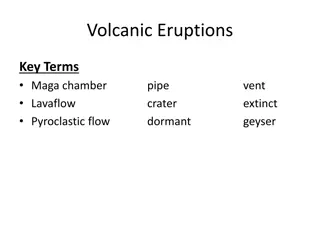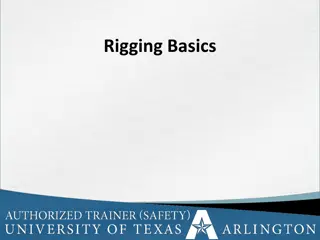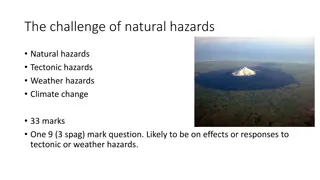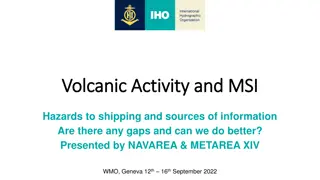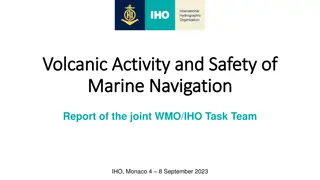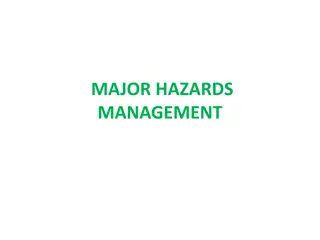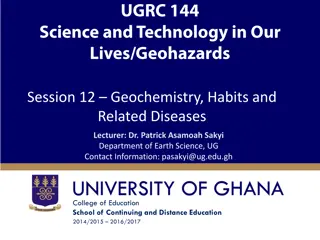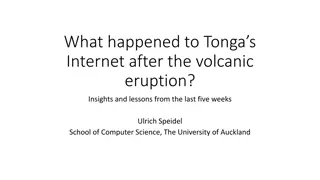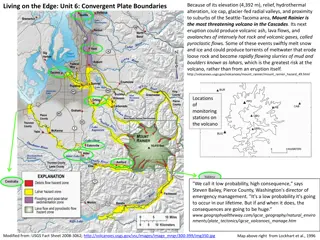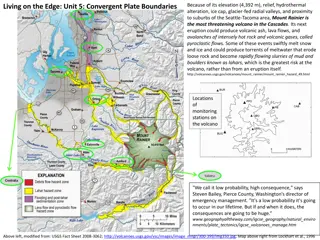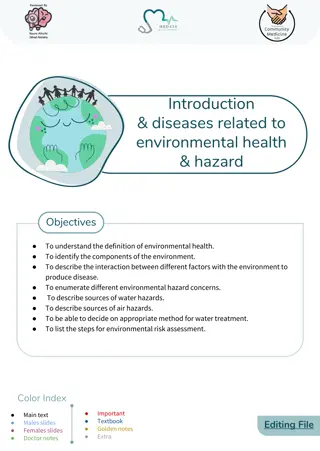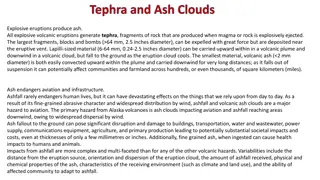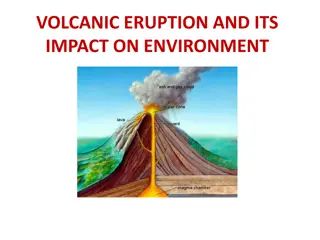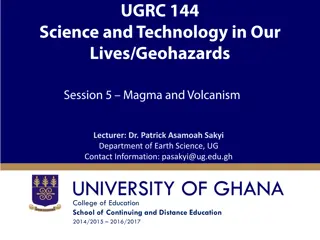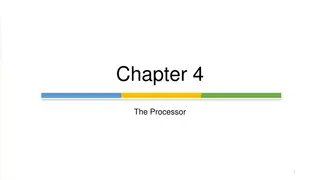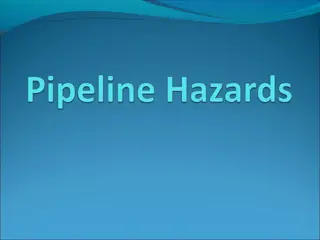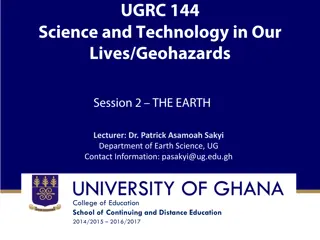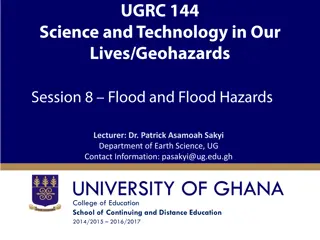Understanding Volcanic Hazards: Session Overview by Dr. Patrick Asamoah Sakyi
This session by Dr. Patrick Asamoah Sakyi introduces students to the hazards associated with volcanoes, covering topics such as volcanic eruption components, primary and secondary effects of volcanic hazards, beneficial aspects of volcanism, and predicting volcanic eruptions. The session also includes recommended reading materials to delve deeper into the subject.
Uploaded on Sep 24, 2024 | 0 Views
Download Presentation

Please find below an Image/Link to download the presentation.
The content on the website is provided AS IS for your information and personal use only. It may not be sold, licensed, or shared on other websites without obtaining consent from the author. Download presentation by click this link. If you encounter any issues during the download, it is possible that the publisher has removed the file from their server.
E N D
Presentation Transcript
Lecturer: Dr. Patrick Asamoah Sakyi Department of Earth Science, UG Contact Information: pasakyi@ug.edu.gh College of Education School of Continuing and Distance Education 2014/2015 2016/2017
Session Overview This session introduces students to Hazards associated with volcanoes. The eruption of molten material in the form of lava on the surface of the earth has the potential to cause hazards. Hazards associated with volcanoes are dependent on how volcanic materials like lava, rock fragments and gases are produced and ejected to the surface of the earth. The extent of travel of lava on the surface and potential hazard associated with it, also depends on the temperature, composition and viscosity of the lava. All these will be discussed in this session. Slide 2 Dr. Patrick A. Sakyi, Dept. of Earth Science
Session Outline The key topics to be covered in the session are as follows: Topic One Components of Volcanic Eruption Topic Two Volcanic Hazard - Primary Effects Topic Three Volcanic Hazard -Secondary & Tertiary Effects Topic Four Beneficial Aspects of Volcanism Topic Five - Predicting Volcanic Eruption Slide 3 Dr. Patrick A. Sakyi, Dept. of Earth Science
Reading List Chapter 5 of Environmental Geology 4th Edition by Carla W Montgomery (1995) Read Unit 1, Section 5 of UGRC 140 II Geohazards Institute of Continuing and Distance Education Slide 4 Dr. Patrick A. Sakyi, Dept. of Earth Science
Topic One COMPONENTS OF VOLCANIC ERUPTION Slide 5 Dr. Patrick A. Sakyi, Dept. of Earth Science
Components of Volcanic Eruption The components of volcanic eruption are; Lava Flow Hot Ash Flows (pyroclastic flows) Ash Falls (tephra falls) Volcanic Gases Mudflows (lahars) Volcanic Landslides (debris flows and debris avalanches) Slide 6 Dr. Patrick A. Sakyi, Dept. of Earth Science
Topic Two VOLCANIC HAZARD - PRIMARY EFFECTS Slide 7 Dr. Patrick A. Sakyi, Dept. of Earth Science
Volcanic Hazard - Primary Effect Lava Flows Lava flows have been known to travel as fast as 64 km/hr; most are slower and give people time to move out of the way. However, lava flows are most damaging to property, as they can destroy anything in their path. Slide 8 Dr. Patrick A. Sakyi, Dept. of Earth Science
Volcanic Hazard - Primary Effect Lava Flows Control of lava flows has been attempted with limited success by bombing flow fronts to attempt to divert the flow, and by spraying with water to cool the flow. Slide 9 Dr. Patrick A. Sakyi, Dept. of Earth Science
Volcanic Hazard - Primary Effect Violent Eruptions and Pyroclastic Activity Pyroclastic materials is the name given to particles produced in volcanic eruptions. Hot pyroclastic flows cause death by suffocation and burning. Pyroclastic material can travel so rapidly that few humans can escape. Recall the 2010 volcanic eruption in Iceland that produced a lot of ash and disrupted air travel for more than one week? Slide 10 Dr. Patrick A. Sakyi, Dept. of Earth Science
Volcanic Hazard - Primary Effect Violent Eruptions and Pyroclastic Activity Pyroclastic materials is the name given to particles produced in volcanic eruptions. Hot pyroclastic flows cause death by suffocation and burning. Pyroclastic material can travel so rapidly that few humans can escape. Recall the 2010 volcanic eruption in Iceland that produced a lot of ash and disrupted air travel for more than one week? Slide 11 Dr. Patrick A. Sakyi, Dept. of Earth Science
Volcanic Hazard - Primary Effect Violent Eruptions and Pyroclastic Activity Tephra falls can blanket an area like snow, but they are far more destructive because tephra deposits have a density more than twice that of snow and tephra deposits do not melt like snow. Tephra falls destroy vegetation, including crops, and can kill livestock that eat the ash covered vegetation. Tephra falls can cause loss of agricultural activity for years after an eruption, a secondary or tertiary effect. * Tephra is a mixture of volcanic ash and other fragments Dr. Patrick A. Sakyi, Dept. of Earth Science Slide 12
Volcanic Hazard - Primary Effect Violent Eruptions and Pyroclastic Activity Tephra falls can blanket an area like snow, but they are far more destructive because tephra deposits have a density more than twice that of snow and tephra deposits do not melt like snow. Tephra falls destroy vegetation, including crops, and can kill livestock that eat the ash covered vegetation. Tephra falls can cause loss of agricultural activity for years after an eruption, a secondary or tertiary effect. Blanket of Tephra * Tephra is a mixture of volcanic ash and other fragments Dr. Patrick A. Sakyi, Dept. of Earth Science Slide 13
Volcanic Hazard - Primary Effect Poisonous Gas Emissions Volcanoes emit gases that are often poisonous to living organisms. Among these poisonous gases are: Tephra falls destroy vegetation, including crops, and can kill livestock that eat the ash covered vegetation. Hydrogen Chloride (HCl), - Hydrogen Sulfide (H2S), Sulfur Dioxide (SO2), Carbon Monoxide (CO), - Hydrogen Fluoride (HF), - *Carbon Dioxide (CO2), and *Water Vapour (H2O). Slide 14 Dr. Patrick A. Sakyi, Dept. of Earth Science
Volcanic Hazard - Primary Effect Poisonous Gas Emissions For example, in 1984, CO2 gas escaping from the bottom of Lake Monoun, a crater lake in the African country of Cameroon, killed 37 people. Again, in 1986, an even larger accumulated CO2 gas emission from Lake Nyos in Cameroon killed more than 1700 people and 3000 cattle. The best defense against hazardous volcanic gases is to get well away from the erupting volcano or escaping gases as quickly as possible Slide 15 Dr. Patrick A. Sakyi, Dept. of Earth Science
Volcanic Hazard Secondary and Tertiary Effects Mudflows (Lahars) Volcanoes can emit voluminous quantities of loose, unconsolidated tephra which become deposited on the landscape. Such loose deposits are subject to rapid removal if they are exposed to a source of water The source of water can be derived by; melting of snow or ice during the eruption, emptying of crater lakes during an eruption, or rainfall that takes place any time with no eruption. Slide 16 Dr. Patrick A. Sakyi, Dept. of Earth Science
Volcanic Hazard Secondary and Tertiary Effects Mudflows (Lahars) Mudflows are a mixture of water and sediment. They move rapidly down slope along existing stream valleys, although they may easily top banks and flood out into surrounding areas. They have properties that vary between thick water and wet concrete, and can remove anything in their paths like; bridges, highways, houses, etc. Dr. Patrick A. Sakyi, Dept. of Earth Science Slide 17
Volcanic Hazard Secondary and Tertiary Effects Debris Avalanches and Debris Flows Volcanic mountains tend to become over-steepened as a result of the addition of new material over time. Over-steepened slopes may become gravitationally unstable, leading to a sudden slope failure that results in landslides, debris slides or debris avalanches. Occurrence of debris avalanches, landslides, and debris flows are not necessarily accompanied by a volcanic eruption. Slide 18 Dr. Patrick A. Sakyi, Dept. of Earth Science
Volcanic Hazard Secondary and Tertiary Effects Flooding Drainage systems can become blocked by deposition of pyroclastic flows and lava flows. Such blockage may create a temporary dam that could eventually be filled with water and fail resulting in floods downstream from the natural dam Volcanoes in cold climates can melt snow and glacial ice, rapidly releasing water into the drainage system and possibly causing floods. Slide 19 Dr. Patrick A. Sakyi, Dept. of Earth Science
Volcanic Hazard Secondary and Tertiary Effects Tsunami Debris avalanche events, landslides, caldera collapse events, and pyroclastic flows entering a body of water may generate tsunami. For example, in 1883 a tsunami, triggered by pyroclastic flow entering the sea in Sumatra, Indonesia killed about 36,600 people, some as far as 200 km away from the volcano. Slide 20 Dr. Patrick A. Sakyi, Dept. of Earth Science
Volcanic Hazard Secondary and Tertiary Effects Volcanic Earthquakes and Tremors Earthquakes usually precede and accompany volcanic eruptions, as magma intrudes and moves within the volcano. Most volcanic earthquakes are small, but some are large enough to cause damage in the area immediately surrounding the volcano, Some are large enough to trigger landslides and debris avalanches Slide 21 Dr. Patrick A. Sakyi, Dept. of Earth Science
Volcanic Hazard Secondary and Tertiary Effects Volcanic Earthquakes and Tremors Volcanic Tremor (also called harmonic tremor) is a type of continuous periodic shaking of the ground that is generated by magma moving underground. Slide 22 Dr. Patrick A. Sakyi, Dept. of Earth Science
Volcanic Hazard Secondary and Tertiary Effects Atmospheric Effects Since large quantities of tephra and volcanic gases can be injected into the atmosphere, volcanism can have a short-term effect on climate. Volcanic ash can cause reflection of solar radiation, and thus can cause the temperatures to be cooler for several years after a large eruption. Slide 23 Dr. Patrick A. Sakyi, Dept. of Earth Science
Volcanic Hazard Secondary and Tertiary Effects Atmospheric Effects E.g., Volcanic gases like SO2 also reflect solar radiation, thus lowering the average temperature. Volcanic gases like CO2 are greenhouse gases which help keep heat in the atmosphere. Slide 24 Dr. Patrick A. Sakyi, Dept. of Earth Science
Volcanic Hazard Secondary and Tertiary Effects Famine and Disease Tephra falls can cause extensive crop damage and kill livestock. This can lead to famine. Displacement of human populations, breakdown of sewerage and water systems, cut off of other normal services can lead to a number of diseases. Slide 25 Dr. Patrick A. Sakyi, Dept. of Earth Science
Topic Four BENEFICIAL ASPECTS OF VOLCANISM Slide 26 Dr. Patrick A. Sakyi, Dept. of Earth Science
Beneficial Aspects of Volcanism Even though this course concentrates on the damaging effects of volcanism, Volcanism helps renew the soil, and soils around active volcanoes are some the richest on earth. Hydrothermal processes associated with volcanism produce rich ore deposits. The heat rising around magma bodies can sometimes be tapped to produce geothermal energy. Slide 27 Dr. Patrick A. Sakyi, Dept. of Earth Science
Topic Five PREDICTING VOLCANIC ERUPTIONS Slide 28 Dr. Patrick A. Sakyi, Dept. of Earth Science
Predicting Volcanic Eruptions Active Volcano An active volcano is a volcano that has shown eruptive activity within recent (recorded) history, possibly in the past ~10,000. Thus an active volcano needs not be in eruption to be considered active. Globally there are about 550 active volcanoes, and each year 50 to 70 volcanoes actually erupt. Examples of active volcanoes Stromboli (Italy)-erupting for more than 1000 years, Sinabung (Indonesia) Mt. Etna (Italy), Kilauea Volcano (Hawaii, USA) Slide 29 Dr. Patrick A. Sakyi, Dept. of Earth Science
Predicting Volcanic Eruptions Active Volcano An active volcano is a volcano that has shown eruptive activity within recent (recorded) history, possibly in the past ~10,000. Thus an active volcano needs not be in eruption to be considered active. Globally there are about 550 active volcanoes, and each year 50 to 70 volcanoes actually erupt. Examples of active volcanoes Stromboli (Italy)-erupting for more than 1000 years, Sinabung (Indonesia) Mt. Etna (Italy), Kilauea Volcano (Hawaii, USA) Slide 30 Dr. Patrick A. Sakyi, Dept. of Earth Science
Predicting Volcanic Eruptions Dormant Volcano A dormant volcano (sleeping volcano) is somewhere between active and extinct. A dormant volcano is one that has not shown eruptive activity within recorded history, but shows geologic evidence of activity within the geologic recent past. Slide 31 Dr. Patrick A. Sakyi, Dept. of Earth Science
Predicting Volcanic Eruptions Dormant Volcano (contd.) Thus, it is a volcano that hasn t erupted in the past 10,000 years, but which is expected to erupt again. Dormant volcano normally appears fresh-looking and not too eroded or worn down. Examples are; Mauna Kea (Hawaii, USA), Mauna Loa (Hawaii, USA) & Mt Killimanjaro (Tanzania) Slide 32 Dr. Patrick A. Sakyi, Dept. of Earth Science
Predicting Volcanic Eruptions Extinct Volcano An extinct (dead) volcano is a volcano that has not shown any historic activity, usually only the heavily eroded lava plug remaining, no fumarolic activity and shows no signs of recent eruptive history. Examples are; Mt Ashitaka (or Ashitakayama-Japan) Yellowstone Caldera (USA)-has not erupted for 640,000 yrs. Slide 33 Dr. Patrick A. Sakyi, Dept. of Earth Science
Summary In this session, we have looked at the components of volcanic eruption such as lava flow, mudflow, pyroclastic material, and gases. We have also looked at the primary and secondary effects of volcanic hazards such as flooding, destruction of vegetation as well as causing the death of livestock. The session also touched on the beneficial aspects of volcanism such as renewing soil and the formation of ore deposits Slide 34 Dr. Patrick A. Sakyi, Dept. of Earth Science
END Slide 35 Dr. Patrick A. Sakyi, Dept. of Earth Science
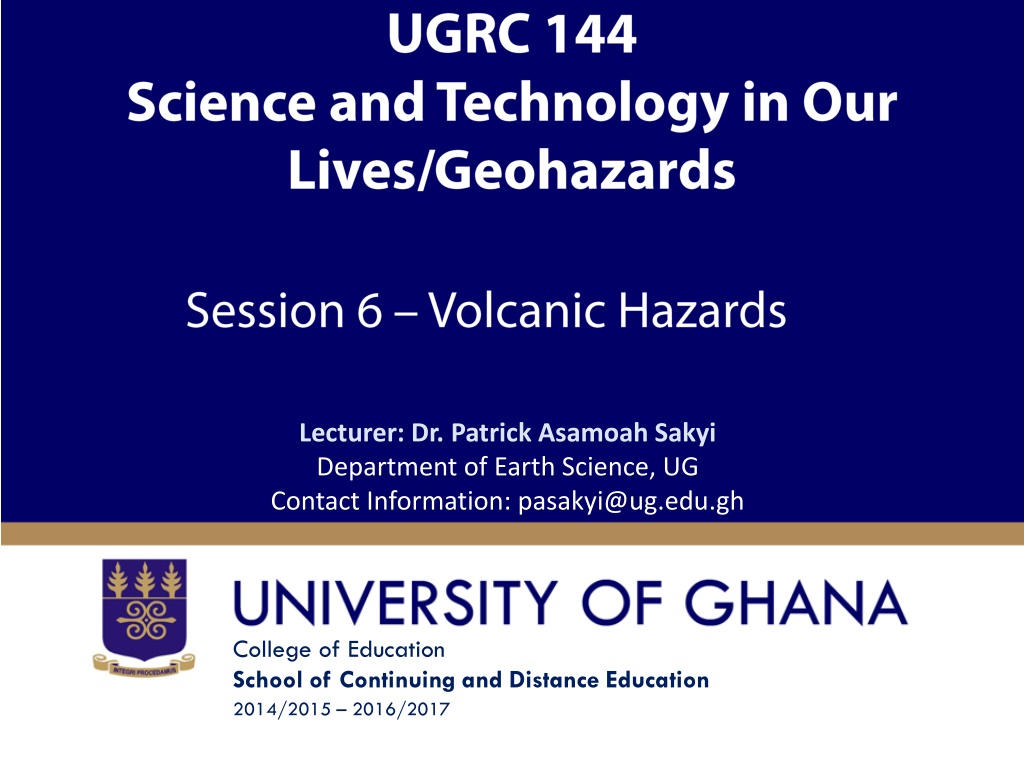

![Read⚡ebook✔[PDF] Io After Galileo: A New View of Jupiter's Volcanic Moon (Sprin](/thumb/21612/read-ebook-pdf-io-after-galileo-a-new-view-of-jupiter-s-volcanic-moon-sprin.jpg)

